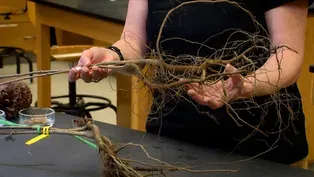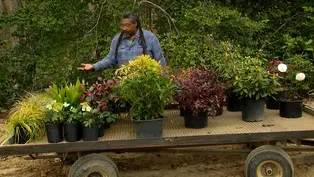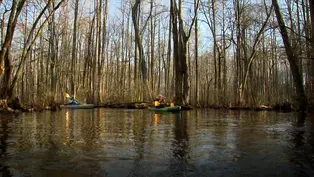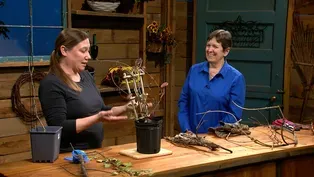Virginia Home Grown
Caring for Champion Trees
Clip: Season 25 Episode 1 | 8m 11sVideo has Closed Captions
Learn how champion trees are measured and the special care they receive
Peggy Singlemann visits Maymont to view the collection of large trees with Sean Proietti. The historic park features many state and national champion trees that receive special care. Featured on VHG episode 2501, March 2025..
Problems with Closed Captions? Closed Captioning Feedback
Problems with Closed Captions? Closed Captioning Feedback
Virginia Home Grown is a local public television program presented by VPM
Virginia Home Grown
Caring for Champion Trees
Clip: Season 25 Episode 1 | 8m 11sVideo has Closed Captions
Peggy Singlemann visits Maymont to view the collection of large trees with Sean Proietti. The historic park features many state and national champion trees that receive special care. Featured on VHG episode 2501, March 2025..
Problems with Closed Captions? Closed Captioning Feedback
How to Watch Virginia Home Grown
Virginia Home Grown is available to stream on pbs.org and the free PBS App, available on iPhone, Apple TV, Android TV, Android smartphones, Amazon Fire TV, Amazon Fire Tablet, Roku, Samsung Smart TV, and Vizio.
Providing Support for PBS.org
Learn Moreabout PBS online sponsorship>>Maymont was originally the home of James and Sallie Dooley.
This was their home and estate from 1893 to 1925.
Then that's when they established this arboretum.
Sallie May Dooley was an avid horticulturalist and when they purchased the land, it was farmland, which they began cultivating into beautiful English-style park, and that parkland includes the arboretum.
We know they went to Europe many times, and we see that reflected in their Italian gardens, but they clearly had an interest in Asia as well, which we also see, in their trees as well as our famous Japanese garden.
>>Sean, I do love this tree.
It's so beautiful.
It's so big and majestic.
>>This is one of my favorites, too.
This is the Blue Atlas Cedar, and it's from the Atlas Mountains of Northern Africa and was therefore part of the Dooleys' program of bringing in trees from all over the world.
>>You know, they picked some amazing specimens.
They really did.
This tree is so big though.
>>They don't start that way.
Blue Atlas Cedars look a little scraggly, you know, for the first 30-35 years of their life.
And then they really come into their own much later.
But this is one of our champion trees here, meaning, of all the Blue Atlas Cedars in the entire state of Virginia, this one is the biggest of all.
>>That is so cool.
So what makes a tree a champion tree?
>>Pure size.
You have the diameter of the trunk of the tree.
You have the height.
And then you have the width of the crown.
And then each of those three categories is given a point number.
And then those points are added together, and that makes the overall score.
>>So the highest score wins.
>>That's right, the biggest tree.
>>Well, this certainly is deserving of that.
>>Yes, but you don't have to be a huge tree to be a champion.
You just have to be the biggest yourself that you can be, so you know, some of our champion trees, like the Tigertail Spruce by the fountain or the Japanese tree lilac, they're not necessarily impressive trees that anybody would come and notice that it could be a champion.
They're just really doing the best that they can to be themselves.
>>Yes (chuckles), the biggest of their kind.
>>That's right.
>>Within these beautiful 100 acres, how many champion trees are there at Maymont?
>>It changes all the time.
We have about 15 to 18 right now, and even I have to go on the Virginia Tech Big Tree Database website to find out exactly how many we have, because, sure, one of our trees could fall down and lose its champion status, but equally, somebody else could realize that they have a champion in their own yard.
And then ours gets bumped down the list, which has happened many times before.
>>Yes, and it's variable.
>>Yes, and it's fun because it makes it a competition, right?
I personally love the fact that, if somebody looks at our Deodars, and goes home and thinks, "You know, I think mine's probably bigger," and measures theirs... Let 'em have it.
>>Let 'em have it.
At least, they're becoming tree-aware.
>>Exactly.
>>So tell me, what is a Dooley tree?
>>A Dooley tree here at Maymont means a tree that goes back to the original estate, and we kinda go back and forth on the definition sometimes for purposes of data collection, like in the case of this Blue Atlas Cedar.
This tree was here when the Dooleys were here.
But behind you, the elms, those trees weren't there when the Dooleys were there, but the Dooleys did have elms there.
So depending on kind of what function we're trying to express, like, either of those may be considered Dooley trees.
>>These trees were planted on a private estate, but now they're growing in a public park.
So what are the challenges they face with that new...
I'll say, "Use of the property."
>>Violent.
(Peggy and Sean laugh) You know, sometimes, it's, like, little boys hitting them with sticks.
They can't really do that much damage, but you know, we've also had people just rip branches off of them.
You know, I think people just are not as in touch with the natural world anymore and they don't really realize that these are fragile organisms.
>>And that they're living organisms.
>>Exactly, yes.
>>So how do you take care of these majestic trees?
>>There's all kinds of ways.
With old trees, the main thing is to not do anything that shocks them.
We often use compost as, like, a low-grade fertilizer.
We use wood chips to, basically, help the soil biome and keep all those microorganisms in there and keep the soil healthy, but you never wanna fertilize a tree and shock it by putting a lot of growth on it.
So we just, you know, kind of try and keep them happy.
The other thing that we do is trying to preserve the structure that's there, as opposed to doing, like, radical pruning, so we will use cabling, which allows the tree to move in tandem with wind shear, instead of having certain segments of the tree be exposed to wind shear individually.
Similarly, you can use brace rods, and that does the same effect, to not stress some of these limbs.
The larger trees may have overextended limbs that hold quite a lot of mass far away from the trunk, so we wanna try and keep all of that mass centered.
>>Well, speaking of mass, we all know that some big trees are actually like big sails.
What else can we do to help- >>That's right.
>>with that situation with these crazy storms that we're getting?
>>That is one example where pruning is kind of beneficial.
What you can do is do crown thinning to take out portions of the interior of the tree, and that allows the wind to pass through the crown of the tree without catching so much of that surface area of the leaf.
>>So you're not just scalping off the tree.
You're going in and making judgment calls as to what pieces to remove.
>>Yes, and it really... You never wanna remove 20-25% on, like, young trees, and on old trees, significantly less than that, so it really requires having an experienced arborist be a guide.
>>Yes, and I'm sure there's many arborists that help here at Maymont.
>>With the significance of these trees and the significance of the property, we try to never make decisions just one person making that decision.
We try and have it be a team of specialists.
>>Yes, so careful.
So important.
But when a tree does start to decline, are there any action steps that you go, "Oh my gosh, what can we do?"
>>There are.
So, we have a couple of trees that are suffering from bot canker, which is really, really common with cherries.
Many cherries will get it over the course of their lifetime.
But one thing that we've done recently is we AirSpaded the roots and reintroduced biochar into the soil, and that's something that we're starting here, and we would love to make it kinda more of our program, so we're trialing that a little bit right now.
The first year that, you know, you've disturbed that soil, you're gonna wanna make sure that that plant stays nice and watered, same as you would any new planting.
Basically, what we do is we take a 250-gallon tank and bring the tank there and just kinda run a hose to the base of the tree and let it soak that entire area.
You can use a sprinkler system as well.
>>Do you water any other big trees around here?
>>Rarely.
Usually, once a tree is past two years of its establishment, you don't normally need to water it, but during really prolonged periods of drought, we will water some of the more... Prized specimens let's say.
>>Well, Sean, I applaud you on everything you're doing here, taking care of all of these specimens and just keeping 'em alive and strong and healthy for people to come and enjoy now and in the future.
>>And thank you for all the work that you've done for the same program.
>>You're welcome.
We make a great team.
>>That's right.
>>Mrs.
Dooley was very interested in making sure that she bought the best, (laughs) so whenever she was seeking out new plantings for her estate, she was buying the best ones she could find from all over the East Coast.
Our current philosophy is that we do try to replace in kind whenever something is lost of the original collection.
You will continue to, hopefully, see Maymont just as they saw it 100 years ago 100 years from now.
(bird chirps)
Video has Closed Captions
Learn the correct root to shoot ratio for planting new trees (3m 17s)
Video has Closed Captions
Learn about the many types of life recently discovered inside of trees (6m 42s)
Video has Closed Captions
Explore shrubs and groundcovers that grow well under big trees (3m 11s)
Video has Closed Captions
Explore the Dragon Run watershed, one of Virginia’s most pristine natural sites (8m 4s)
Video has Closed Captions
Learn the differences in native and invasive vines (5m 20s)
Providing Support for PBS.org
Learn Moreabout PBS online sponsorshipVirginia Home Grown is a local public television program presented by VPM
















